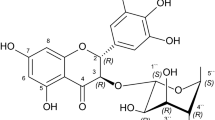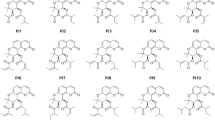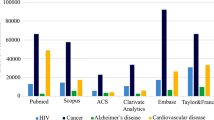Abstract
(–)-Huperzine A (HupA) is found in an extract from a club moss that has been used for centuries in Chinese folk medicine. Its action has been attributed to its ability to strongly inhibit acetylcholinesterase (AChE). The crystal structure of the complex of AChE with optically pure HupA at 2.5 Å resolution shows an unexpected orientation for the inhibitor with surprisingly few strong direct interactions with protein residues to explain its high affinity. This structure is compared to the native structure of AChE devoid of any inhibitor as determined to the same resolution. An analysis of the affinities of structural analogues of HupA, correlated with their interactions with the protein, shows the importance of individual hydrophobic interactions between HupA and aromatic residues in the active-site gorge of AChE
This is a preview of subscription content, access via your institution
Access options
Subscribe to this journal
Receive 12 print issues and online access
$189.00 per year
only $15.75 per issue
Buy this article
- Purchase on Springer Link
- Instant access to full article PDF
Prices may be subject to local taxes which are calculated during checkout
Similar content being viewed by others
References
Liu, J.-S. et al. The structures of huperzine A and B, two new alkaloids exhibiting marked anticholinesterase activity. Can. J. Chem. 64, 837–839 (1986).
Wang, Y.E., Yue, D.X. & Tang, X.-C. Anticholinesterase activity of huperzine A. Acta Pharmacol. Sinica 7, 110–113 (1986).
Kozikowski, A.P., Thiels, E., Tang, X.-C. & Hanin, I. Huperzine A – A possible lead structure in the treatment of Alzheimer's disease. Adv. Med. Chem. 1, 175–205 (1992).
Tang, X.C., Xiong, Z.Q., Qian, B.C., Zhou, Z.F. & Zhang, C.L. Cognition improvement by oral Huperzine A: a novel acetylcholinesterase inhibitor, in Alzheimer Disease: Therapeutic Strategies (eds E. Giacobini & R. Becker) 113–119 (Birkhäuser, Boston, 1994).
Dunnett, S.B. & Fibiger, H.C. Role of forebrain cholinergic systems in learning and memory: relevance to the cognitive deficits of aging and Alzheimer's dementia. Prog. Brain Res. 98, 413–420 (1993).
Becker, R.E. & Giacobini, E. Cholinergic Basis for Alzheimer Therapy (Birkhäuser, Boston, 1991).
Davis, K.L. & Powchik, P. Tacrine. Lancet 345, 625–630 (1995).
Giacobini, E. & Becker, R. Alzheimer Disease: Therapeutic Strategies (Birkhäuser, Boston, 1994).
Laganière, S., Corey, J., Tang, X.-C., Wülfert, E. & Hanin, I. Acute and chronic studies with the anticholinesterase huperzine A: Effect on central nervous system cholinergic parameters. Neuropharmacology 30, 763–768 (1991).
Xiong, Z.Q. & Tang, X.C. Effect of Huperzine A, a novel acetylcholinesterase inihibitor, on radial maze performance in rats. Pharmacol. Biochem. Behavior 51, 415–419 (1995).
Zhang, R.W. et al. Drug evaluation of huperzine A in the treatment of senile memory disorders. Acta Pharmacol. Sinica 12, 250–252 (1991).
Ved, H.S., Koenig, M.L., Dave, J.R. & Doctor, B.P. Huperzine A decreases neuronal cell death caused by glutamate. Neurobiol. Aging, submitted.
Geib, S.J., Tückmantel, W. & Kozikowski, A.P. Huperzine A - a potent acetylcholinesterase inhibitor of use in the treatment of Alzheimer's disease. Acta Crystallogr. 47, 824–827 (1991).
Ashani, Y., Grunwald, J., Kronman, C., Velan, B. & Shafferman, A. Role of tyrosine 337 in the binding of huperzine A to the active site of human acetylcholinesterase. Mol. Pharmacol. 45, 555–560 (1994).
McKinney, M., Miller, J.H., Yamada, F., Tückmantel, W. & Kozikowski, A.P. Potencies and stereoselectvities of enantiomers of huperzine A for inhibition of rat cortical acetylcholinesterase. Eur. J. Pharmacol. 203, 303–305 (1991).
Saxena, A. et al. Identification of amino acid residues involved in the binding of Huperzine A to cholinesterases. Prot. Sci. 3, 1770–1778 (1994).
Pang, Y.-P. & Kozikowski, A. Prediction of the binding sites of huperzine A in acetylcholinesterase by docking studies. J. Computer-Aided Mol. Design 8, 669–681 (1994).
Sussman, J.L. et al. Atomic structure of acetylcholinesterase from Torpedo californica: a prototypic acetylcholine-binding protein. Science 253, 872–879 (1991).
Harel, M. et al. Quaternary ligand binding to aromatic residues in the active-site gorge of acetylcholinesterase. Proc. Natl. Acad. Sci. USA 90, 9031–9035 (1993).
Axelsen, P.H., Harel, M., Silman, I. & Sussman, J.L. Structure and dynamics of the active site gorge of acetylcholinesterase: synergistic use of molecular dynamics simulation and X-ray crystallography. Prot. Sci. 3, 188–197 (1994).
Harel, M., Quinn, D.M., Nair, H.K., Silman, I. & Sussman, J.L. The X-ray structure of a transition state analog complex reveals the molecular origins of the catalytic power and substrate specificity of acetylcholinesterase. J. Am. Chem. Soc. 118, 2340–2346 (1996).
Wlodek, S.T. et al. in Enzymes of the cholinesterase family (eds. Balasubramanian, A.L., Doctor, B.P., Taylor, P. & Quinn, D.M.) 97–104 (Plenum Press, New York, 1995).
Dougherty, D.A. Cation-π interactions in chemistry and biology: a new view of benzene, Phe, Tyr and Trp. Science 271, 163–168 (1996).
Kozikowski, A.P. et al. Synthesis of huperzine A and its analogues and their anticholinesterase activity. J. Org. Chem. 56, 4636–4645 (1991).
Verdonk, M.L., Boks, G.J., Kooijman, H., Kanters, J.A. & Kroon, J. Stereochemistry of charged nitrogen-aromatic interactions and its involvement in ligand-receptor binding. J. Computer-Aided Mol. Design 7, 173–182 (1993).
Sussman, J.L., Seeman, N.C., Kim, S.-H. & Berman, H.M. The crystal structure of a naturally occurring dinucleotide phosphate uridylyl 3′,5′-adenosine phosphate. models for RNA chain folding. J. Mol. Biol. 66, 403–421 (1972).
Taylor, R. & Kennard, O. Crystallographic evidence for the existence of C-H…O, C-H….N, and C-H…Cl hydrogen bonds. J. Am. Chem. Soc. 104, 5063–5070 (1982).
Derewenda, Z.S., Derewenda, U. & Kobos, P.M. (His) C-H…O=C< hydrogen bond in the active sites of serine hydrolases. J. Mol. Biol. 241, 83–93 (1994).
Kozikowski, A.P. et al. Identification of a more potent analogue of the naturally occurring alkaloid Huperzine A; predictive molecular modeling of its interaction with AChE. J. Am. Chem. Soc. 118, 11357–11362 (1996).
Harel, M., Kleywegt, G.J., Ravelli, R.B.G., Silman, I. & Sussman, J.L. Crystal structure of an acetylcholinesterase-fasciculin complex: interaction of a three-fingered toxin from snake venom with its target. Structure 3, 1355–1366 (1995).
Jones, T.A., Zou, J.-Y., Cowan, S.W. & Kjeldgaard, M. Improved methods for building protein models in electron density maps and the location of errors in these models. Acta Crystallogr. A47, 110–119 (1991).
Ashani, Y., Peggins III, J.O. & Doctor, B.P. Mechanism of inhibition of cholinesterases by huperzine A. Biochem. Biophys. Res. Comm. 184, 719–726 (1992).
Sussman, J.L. et al. Purification and crystallization of a dimeric form of acetylcholinesterase from Torpedo californica subsequent to solubilization with phosphatidylinositol-specific phospholipase C. J. Mol. Biol. 203, 821–823 (1988).
McPherson, A. The growth and preliminary investigation of protein and nucleic acid crystals for X-ray diffraction analysis. Meth. Biochem. Anal. 23, 249–345 (1976).
Otwinowski, Z. Oscillation data reduction program, in Data Collection and Processing, Proceedings of the CCP4 Study Weekend 29–30 January 1993 (eds L. Sawyer, N. Isaacs & S. Bailey) 56–62 (SERC, Daresbury, 1993).
Brünger, A.T., Kuriyan, J. & Karplus, M. Crystallographic R factor refinement by molecular dynamics. Science 235, 458–460 (1987).
Engh, R.H. & Huber, R. Accurate bond and angle parameters for X-ray protein structure refinement. J. Appl. Crystallogr. A47, 392–400 (1991).
Laskowski, R.A., MacArthur, M.W., Moss, D. & Thornton, J.M. PROCHECK: A program to check the stereochemical quality of protein structures. J. Appl. Crystallogr. 26, 283–291 (1993).
Vriend, G. WHAT IF: a molecular modelling and drug design program. J. Mol. Graph. 8, 52–56 (1990).
Kleywegt, G.J. & Jones, T.A. Efficient rebuilding of protein structures. Acta Crystallogr. D52, 829–832 (1996).
InsightII v. 2.3.0, (Biosym Technologies, San Diego, 1993)
Wallace, A.C., Laskowski, R.A. & Thornton, J.M. LIGPLOT: a program to generate schematic diagrams of protein-ligand interactions. Protein Engng. 8, 127–134 (1995).
Kozikowski, A.P., Yamada, F., Tang, X.-C. & Hanin, I. Synthesis and biological evaluation of (+/−)-Z-huperzine A. Tetrahedr. Let. 31, 6159–6162 (1990).
Kozikowski, A.P. et al. Delineating the pharmacophoric elements of huperzine A: importance of the unsaturated three-carbon bridge to its AChE inhibitory activity. J. Med Chem. 34, 3399–3402 (1991).
Liu, J.-S. & Huang, M.-F. The alkaloids huperzines C and D and huperzinine from Lycopodiastrum casuarinoides. Phytochemistry 37, 1759–1761 (1994).
Author information
Authors and Affiliations
Rights and permissions
About this article
Cite this article
Raves, M., Harel, M., Pang, YP. et al. Structure of acetylcholinesterase complexed with the nootropic alkaloid, (–)-huperzine A. Nat Struct Mol Biol 4, 57–63 (1997). https://doi.org/10.1038/nsb0197-57
Received:
Accepted:
Issue Date:
DOI: https://doi.org/10.1038/nsb0197-57
This article is cited by
-
The ACE genes in Aphelenchoides besseyi isolates and their expression correlation to the fenamiphos treatment
Scientific Reports (2022)
-
The traditional uses, secondary metabolites, and pharmacology of Lycopodium species
Phytochemistry Reviews (2022)
-
Rational design and synthesis of modified natural peptides from Boana pulchella (anura) as acetylcholinesterase inhibitors and antioxidants
Amino Acids (2022)
-
Acetylcholinesterase inhibitory activity of a naturally occurring peptide isolated from Boana pulchella (Anura: Hylidae) and its analogs
Amino Acids (2020)
-
Demystifying traditional herbal medicine with modern approach
Nature Plants (2017)



